4.0 HERITAGE CONSERVATION
4.1 Protecting the Cultural Resources of the Rideau Canal
Cultural resource management encompasses the identification, evaluation, conservation, and presentation of cultural resources which have historic value. The Historic Canals Policy and the Cultural Resource Management Policy provide direction for the management of the cultural resources of the Rideau Canal. This includes traditional uses of cultural resources where appropriate.
The cultural resources of the Rideau Canal consist of the engineering works, buildings, landscapes, archaeological sites, artifacts and archival resources associated with the military period ( level 1) and post military period operation (level 2) of the Canal. Complementing the cultural resources of the Canal is a cultural landscape setting which has evolved over two hundred years. The Cultural Landscape of the Rideau Canal Corridor Phase II Study describes and evaluates the corridor’s cultural landscapes and recommends actions which should be taken to manage and preserve significant landscapes. This study can be used by municipalities, heritage interests and private landowners to identify and protect the cultural landscape of the Canal corridor.
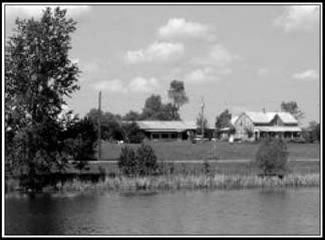 Historic Farmstead near Kars, Manuel Stevens, Parks Canada These scenes are becoming rare as the urban growth expands south towards Kemptville. |
4.2 Current Heritage Conservation Management Activities
- Parks Canada has an ongoing program of monitoring and maintenance of Canal buildings and engineering works to conserve historic fabric and ensure safe and reliable use. As a result 88% of the buildings and 92% of the engineering works are in good to fair condition.
- Known archaeological features on Canal land and on the bed of the Canal are protected.
- Parks Canada participates in the municipal planning and shore-land development review process to encourage sensitive development and preservation of the heritage character of the Canal.
- Many corridor residents value the heritage character of the Rideau Canal corridor and have made substantial contributions to heritage conservation through their own efforts.
- A number of municipalities are working to protect the historical values of the Canal corridor through municipal designations under the provisions of the Ontario Heritage Act and other legislation that contributes to the protection of historic values such as the “Provincial Policy Statement for Land Use Planning”, the Planning Act and the Municipal Act.
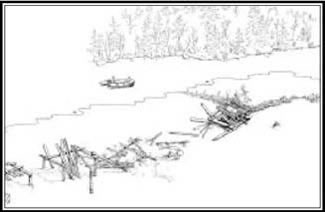 Remains of submerged bridge, Rideau Canal Dorothea Larson, Parks Canada |
4.3 Heritage Conservation Management Challenges:
- Projected funding limitations over the next ten years may affect the ability of the Canal to carry out a comprehensive maintenance and conservation program. As a result, the condition of level 1 and level 2 cultural resources may gradually deteriorate thus making it increasingly difficult to ensure the commemorative integrity of the engineering works and buildings.
- The requirement to ensure navigation throughout the entire system requires that the level 1 and level 2 engineering works must be afforded equal maintenance attention so that they are safe and reliable.
- There is a need for increased information on the location and condition of terrestrial and underwater archaeological resources.
- There is a need to have an inventory and assessment of moveable objects; e.g. artifacts, maps, plans and archaeological artifacts under the stewardship of Parks Canada.
- There is a need to increase public understanding of the Rideau Canal as a National Historic site and Canadian Heritage River.
- The cultural landscape of the Canal corridor is under threat from incompatible development.
- An inventory and assessment of the value of historic buildings and landscapes in the Rideau Canal corridor would be beneficial to raise awareness of their heritage value and support for their preservation.
- The long term integrity of privately owned historic buildings on Canal lands cannot be assured. These are buildings constructed many years ago on land leased from the Canal primarily for residential purposes, some of which have historic value. There are currently no means to ensure their protection.
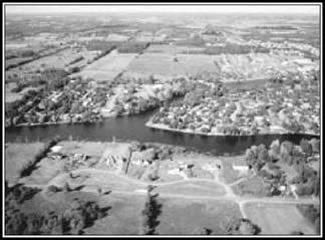 Suburban Development at Manotick, Simon Lunn Estate lot development and subdivisions are changing the cultural landscape south of Ottawa. |
4.4 Strategic Goals:
Manage all cultural resources under the stewardship of Parks Canada in accordance with the principles and practices of the Cultural Resource Management Policy and the FHBRO Code of Practice where applicable so that the values of these resources as identified in the CIS are safeguarded.
Encourage the protection of the other cultural resources within the Rideau Canal corridor
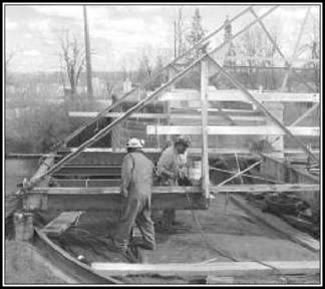 Burritt’s Rapids Swing Bridge, Bill Pratt Canal staff undertaking repairs to the historic bridge. |
4.4.1 Key Actions by Parks Canada
- Undertake a program of ongoing monitoring, maintenance and conservation of engineering works essential for the safe and reliable operation of the Canal and to ensure their commemorative integrity as detailed in the Long Term Capital Plan for the Canal.
- Monitor and undertake a program of conservation maintenance to safeguard the historic values of level 1 and level 2 buildings to ensure their commemorative integrity.
- Conserve significant lockstation cultural landscape features, views and visual linkages so that the values of these landscapes as identified in the CIS are safeguarded.
- Ensure that new landscape elements and uses safeguard the historic values and views of the lockstations.
- Establish agreements with leaseholders to conserve historically significant private buildings on Canal lands.
- Protect areas of archaeological sensitivity, so that the historic values of archaeological resources as identified in the CIS are safeguarded.
- Inventory, evaluate and conserve moveable objects and archaeological artifacts and sites owned by Parks Canada so that their historic values as identified in the CIS are safeguarded.
- Raise awareness of the values of the Rideau Canal identified in the Commemorative Integrity Statement and the application of the cultural resource management policy among staff and stakeholders.
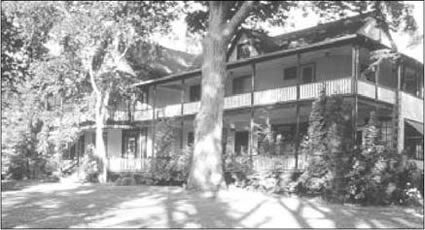 The Opinicon Hotel is a rare surviving example of an early 20th century resort hotel. Rideau Canal Photo Collection |
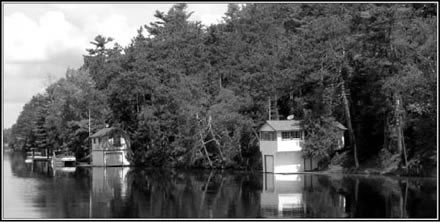 Historic Boathouses on Big Rideau Lake - Manuel Stevens, Parks Canada These charming structures contribute to the historic value of the Canal and are being preserved by their owners. |
4.4.2 Key Actions by Parks Canada in Co-operation with Others
- Encourage municipalities to implement cultural heritage policies in their official plans and establish Heritage Advisory Committees to advise municipal councils on the conservation of historic buildings and landscapes along the Canal.
- Establish a network of heritage agencies and organizations, municipal heritage and land use planning officials to promote the inventory, conservation and monitoring of the significant buildings and cultural landscapes of the Canal corridor.
- Encourage the use of architectural styles in keeping with the architectural heritage of the Canal corridor for new construction adjacent to the Canal and lockstations.
- Identify views and adjacent private lands critical to the protection of the heritage setting of lockstations, and specific corridor communities, and encourage landowners and municipalities to protect these values through private land stewardship, the implementation of appropriate planning tools such as heritage district designation under the provisions of the Ontario Heritage Act, open space policies, heritage easements and zoning bylaws.
- Promote the use of The Cultural Landscape of the Rideau Canal Corridor Phase II Study among heritage interests and municipalities as a means of raising awareness of the cultural resources of the Canal corridor and the protection of these resources through private stewardship and municipal action.
- Co-operate with the Town of Smiths Falls, heritage interests and the owner of the Bascule Bridge National Historic Site of Canada at the detached Lockstation in Smiths Falls to protect this nationally significant structure.
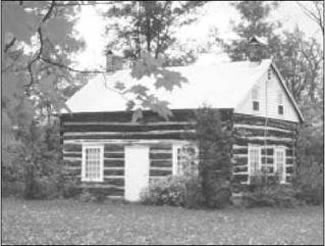 Log House on the county road between Merrickville and Burritt’s Rapids. Rideau Canal Photo Collection |
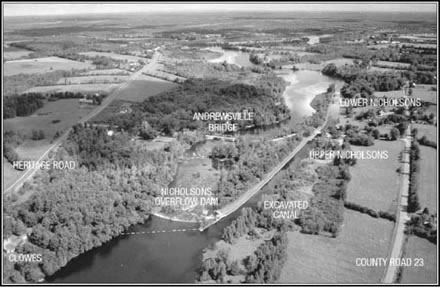 NICHOLSONS LOCKSTATIONS The Andrewsville Bridge, and the Nicholsons and Clowes overflow dams, Simon Lunn |
Related links
- Rideau Canal National Historic Site of Canada
- Foreword
- Table of Contents
- 1.0 INTRODUCTION
- 2.0 COMMEMORATIVE INTEGRITY
- 3.0 VISION AND GUIDING PRINCIPLES
- 5.0 ECOSYSTEM MANAGEMENT
- 6.0 WATERFRONT LAND USE AND DEVELOPMENT
- 7.0 HERITAGE PRESENTATION
- 8.0 VISITOR SERVICES AND FACILITIES
- 9.0 HERITAGE TOURISM AND RECREATION
- 10.0 ADMINISTRATION AND OPERATIONS
- 11.0 WATER MANAGEMENT
- 12.0 ONGOING PARTNERSHIP AND PUBLIC INVOLVEMENT
- 13.0 SUMMARY OF THE ENVIRONMENTAL ASSESSMENT
- 14.0 PLAN IMPLEMENTATION
- APPENDIX A
- 2.0 Purpose and Definition of Commemorative Integrity
- 3.0 Statement of Commemorative Intent
- 4.0 Historic and Geographic Context
- 5.0 The Designated Place
- 6.0. In Situ Resources
- 7.0 Moveable Resources
- 8.0 Messages of National Significance
- 9.0 Level Two In Situ Resources
- 10.0 Level Two Moveable Resources
- 11.0 The Natural Environment of the Rideau Canal Corridor
- 12.0 Heritage Messages Are Communicated to the Public
- Appendix B
- Appendix C
- contact
- Management Plan
- Date modified :